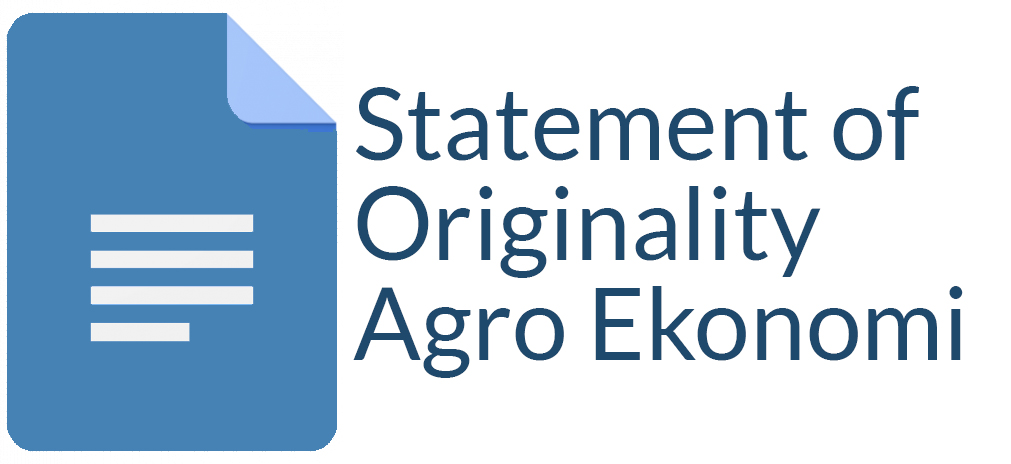The Impact of Government Policies on Competitiveness of Rice Farming in Purbalingga Regency
Asti Nur Afifah(1*), Masyhuri Masyhuri(2), Any Suryantini(3), Lestari Rahayu Waluyati(4)
(1) Master Student of Agricultural Economics, Faculty of Agriculture, Universitas Gadjah Mada
(2) Universitas Gadjah Mada
(3) Faculty of Agriculture, Universitas Gadjah Mada
(4) Faculty of Agriculture, Universitas Gadjah Mada
(*) Corresponding Author
Abstract
Rice is a potential food crop to be developed in Purbalingga Regency, so it is necessary to know its competitiveness so that rice production can be increased. This study aims to (1) determine the competitiveness of rice farming in Purbalingga Regency, and (2) determine the impact of government policies on rice farming in Purbalingga Regency. It used the Policy Analysis Matrix (PAM) as the research method. The research sample was purposively selected from Bukateja Subdistrict because it is the region with the highest rice production in Purbalingga Regency. It used the data of rice farming collected in two seasons, such as MT I (rainy season) and MT II (dry season) with a total sample of 80 rice farmers. The analysis showed that rice farming in Purbalingga Regency in MT I (rainy season) and MT II (dry season) had good level of competitiveness because they had competitive advantages and comparative advantages. The impact of government policies on rice farming output and input for both tradeable and non-tradeable inputs are significant. The government also has applied protective rice farming input-output policy. Based on this research, it is suggested that there is subsidy to improve irrigation networks and subsidy to purchase of modern inputs (agricultural machinery) to increase rice productivity and raise the competitiveness of rice farming in Purbalingga Regency as well as the government needs to maintaining the rice import tariff policy, determining the basic price of rice, and providing input subsidies such as chemical fertilizer.
Keywords
Full Text:
PDFReferences
Amien, I., Runtunuwu, E., Susanti, E., & Surmaini, E. (2011). Goncangan Iklim mengancam Ketahanan Pangan Nasional. Jurnal Pangan, 20(2), 121–132.
Bordey, F. H., Moya, P. F., Beltran, J. C., & Dawe, D. C. (2016). Competitiveness of Philippine Rice in Asia. Philippine: Philippine Rice Research Institute.
Bowo, P. A., Nurayati, A., & Imleesh, R. M. (2016). Analysis of Competitiveness and Government Policy on Rice, Corn and Soybean Farming. Journal of Economics and Policy, 9(2), 159–169.
BPS. (2019). Kabupaten Purbalingga Dalam Angka 2019. Purbalingga: Badan Pusat Statistik Kabupaten Purbalingga.
Emelda, A., Asrul, L., & Mappigau, P. (2014). An Analysis of Competitiveness and Government Policies Impact on Development of Cocoa Farming in Indonesia. Asian Journal of Agriculture and Rural Development, 4(1), 30–35.
Haryanto, L. I., Masyhuri, & Irham. (2018). The Policy Analysis Matrix in Measuring Competitiveness of Maize Farming System in Marginal Areas. Agro Ekonomi, 29(2), 244–260.
Hermanto, S. (2017). Kebijakan Harga Beras ditinjau dari Dimensi Penentu Harga. Forum Penelitian Agro Ekonomi, 35(1), 31–43.
Kikuchi, M., Haneishi, Y., Maruyama, A., Tokida, K., Asea, G., & Tsuboi, T. (2016). The competitiveness of domestic rice production in East Africa : A domestic resource cost approach in Uganda. Journal of Agriculture and Rural Development in the Tropics and Subtropics, 117(1), 57–72.
Koide, N., Robertson, A. W., Ines, A. V. M., Qian, J.-H., & DeWitt, D. G. (2013). Prediction of Rice Production in the Philippines Using Seasonal Climate Forecasts. Journal of Applied Meteorology and Climatology, 52, 552–569. https://doi.org/10.1175/JAMC-D-11-0254.1
Kumalasari, S. N., Sudarso, & Suryanto, A. (2017). Pengaruh Jarak Tanam dan Jumlah Bibit pada Tanaman Padi (Oryza sativa L.) Hibrida Varietas PP3. Jurnal Produksi Tanaman, 5(7), 1220–1227.
Masyhuri, & Novia, R. A. (2014). Marketable Surplus Beras : Ekonomi Perberasan Indonesia. Jakarta (ID): Perhimpunan Ekonomi Perberasan Indonesia.
Misran. (2014). Pengaruh Penggunaan Pupuk terhadap Pertumbuhan dan Hasil Padi Sawah. Jurnal Dinamika Pertanian, XXIX(2), 113–117.
Muyassir. (2012). Efek Jarak Tanam, Umur, dan Jumlah Bibit terhadap Hasil Padi Sawah (Oryza sativa L.). Jurnal Manajemen Sumberdaya Lahan, 1(2), 207–212.
Ogbe, A. O., Okoruwa, V. O., & Saka, O. J. (2011). Competitiveness of Nigerian Rice and Maize Production Ecologies : A policy Analysis Approach. Tropical and Subtropical Agroecosystems, 14, 493–500.
Pearson, S., Gotsch, C., & Bahri, S. (2004). Aplikasi Policy Analysis Matrix pada Pertanian Indonesia. Jakarta: Yayasan Obor Indonesia.
Pusdatin. (2016). Outlook Komoditas Pertanian Sub Sektor Tanaman Pangan. https://doi.org/ISSN : 1907-1507
Rachman, B. (2011). Performa Dayasaing Komoditas Padi. Jurnal Penelitian Pertanian Terapan, 11(2), 84–91.
Septarisco, Y. K. N. J., & Prihtanti, T. M. (2019). Daya Saing Usaha Tani Padi di Kecamatan Susukan Kabupaten Semarang menggunakan Metode PAM (Policy Analysis Matrix). Agrineca, 19(1), 1–15.
Suhardedi, C., Darwanto, D. H., & Irham. (2017). Competitiveness Rice Farming in Sragen Regency. Agro Ekonomi, 28(1), 19–31.
Suharyanto, Rinaldy, J., & Arya, N. N. (2015). Analisis Risiko Produksi Usahatani Padi Sawah di Provinsi Bali. Jurnal Agraris, 1(2), 70–77.
Ugochukwu, A. I., & Ezedinma, C. I. (2011). Intensification of Rice Production Systems in South- eastern Nigeria: A Policy Analysis Matrix Approach. International Journal of Agricultural Management & Development, 1(2), 89–100.Article Metrics
Refbacks
- There are currently no refbacks.
Copyright (c) 2018 Agro Ekonomi

This work is licensed under a Creative Commons Attribution-ShareAlike 4.0 International License.
View My Stats











